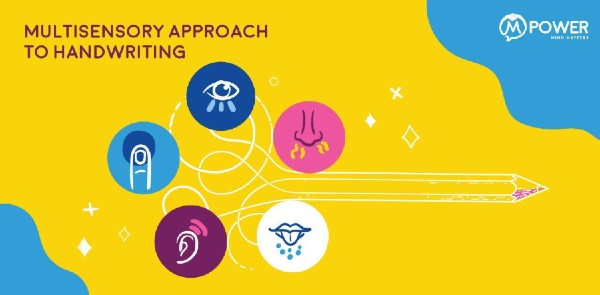
Multisensory Approach for Handwriting

Handwriting is an important form of written communication used in schools. Even during this digital age, handwriting is a foundational skill which can influence a child’s academic performance. Research has found that handwriting has many impacts on a child’s brain – it helps with reading, writing, language use and reasoning.
Since handwriting can help determine a child’s academic performance in the future, it is essential to make sure that the foundation is solid.
Handwriting can be taught in many different ways – one of them being the ‘Multi-sensory Approach’.
As a parent, you might have heard the buzz phrase – ‘Multisensory Approach’. But you may still wonder ‘What exactly does that mean?’.
The multisensory approach refers to using a variety of sensory experiences to stimulate your child, and to help them learn. This involves using all your child’s senses – sight, hearing, smell, taste, touch, and movement.
Now that you know what the ‘Multisensory approach’ is, you might ask ‘How does this help my child’s handwriting?’.
Well, as you already know, every child is different. And therefore, every child learns in a different way. For example, some children learn to write letters by hearing words that describe how to write (auditory learners), some learn by seeing pictures and images of the letters (visual learners) and others learn by actively writing (kinesthetic learners).
When using a multisensory approach, your child is provided with opportunities to learn writing by using all their senses. It gives your child many different ways to engage in handwriting activities. This helps your child because it means that they can learn to write letters in the way that they are most comfortable – thus creating a strong foundation for handwriting.
Furthermore, science tells us that, if a child learns something using multiple senses, that information stays with them longer and they have a better memory of that skill. This hands-on learning allows them to collect and understand the new information more easily. Also, multisensory learning can improve attention, behavior and academic outcomes.
Since the science supports it, a multisensory approach for handwriting is a great way to build a strong academic base for your child.
Letters are the building blocks of handwriting. For your child to write successfully, they first need to master their letter writing skills. To help with this, our occupational therapist, Dr. Jahnavi Shah will be running a Multisensory Letter Writing Camp.
Is your child learning to write letters? Do you want your child to practice letter writing? Does your child find letter writing difficult? Do you want to ensure that your child works on letter writing despite school being closed? If you answered yes to any of these questions then please register here.
Who: 4-6 years (Ideally) parent and child
What: Fun multisensory approach to LEARN, PRACTICE and REFRESH letter writing
When: 12th July, 19th July, 26th July and 2nd August, 2019; 5-6PM
Where: Online
Fees: Rs. 2000/- for 4 sessions over 4 weeks
Image source-Mpowerminds

Exploring Sexual Identity: Navigating Personal Challenges and Building Self-Acceptance
Social Isolation of remote Working: How to stay connected with your team

